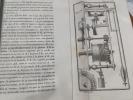BERTHOUD Ferdinand
L'Art de conduire et de règler Les Pendules et Les Montres: A L'Usage de Ceux qui n'ont aucune Connoissance d'Horlogerie.
Paris.Eberhart.An XIII.1805.In-16,demi-relié.93 pages.4 planches dépliantes.Texte et planches en parfait état.Dos avec pièce de titre; en queue traces de vers.
Reference : 40021
Bookseller's contact details
Librairie Ancienne Laurencier
Patrick et Liliane Laurencier
7 rue du Chai des Farines
33000 Bordeaux
France
livresanciens.laurencier@wanadoo.fr
33 05 56 81 68 79
Payment mode



1 book(s) with the same title
L'Art de Conduire et de Régler les Pendules et les Montres : à l'usage de ceux qui n'ont aucune connoissance d'Horlogerie [ Edition originale ]
Par M. Ferdinand Berthoud, Horloger, 1 vol. in-16 reliure de l'époque plein maroquin rouge, dos à 5 nerfs dorés orné, triple filet doré d'encadrement en plats, filet doré en coupes, chasses ornées, gardes de soie verte, toutes tranches dorées, Chez l'Auteur, Michel Lambert, Paris, 1759, 2 ff. blanc, xvj-78 pp., 1 f. n. ch. et 2 ff. blancs, avec 4 planches dépliantes
Magnifique et très rare exemplaire en plein maroquin du temps, aux gardes de soie verte. Sa rareté se mesurera au fait que l'extraordinaire collection Léon Leroy ne contenait pas un tel exemplaire en maroquin. Grand horloger suisse né à Neuchâtel (alors partie du Royaume de Prusse), Ferdinand Berthoud fut l'un des tous premiers à proposer, en 1760, un chronomètre de marine permettant enfin de rivaliser avec l'Angleterre qui disposait des premiers chronomètres de Harrison. Berthoud deviendra Horloger du Roi et de la Marine, avant d'être reçu à l'Académie des Sciences en 1795 ; il laisse une oeuvre d'une ampleur exceptionnelle. Il était soucieux de faire connaître le détail de ses découvertes, et le présent ouvrage est son premier ouvrage de vulgarisation. Magnificent and very rare copy in its original full morocco binding, with green silk endpapers. Its rarity will be measured by the fact that the extraordinary Léon Leroy collection did not contain such a copy in morocco. A great Swiss watchmaker born in Neuchâtel (at the time part of the Royaume de Prusse), Ferdinand Berthoud was one of the very first to offer, in 1760, a french marine chronometer allowing finally to compete with England which had the first chronometers by Harrison. Berthoud will become Watchmaker to the King of France and to the Navy, before being admitted to the Academy of Sciences in 1795; he leaves a work of exceptional magnitude. He wanted to publicize the details of his discoveries, and this book is his first popularization work. Rahir, 318 ; Tardy, Bibliographie de la Mesure du Temps, 30
 Write to the booksellers
Write to the booksellers




